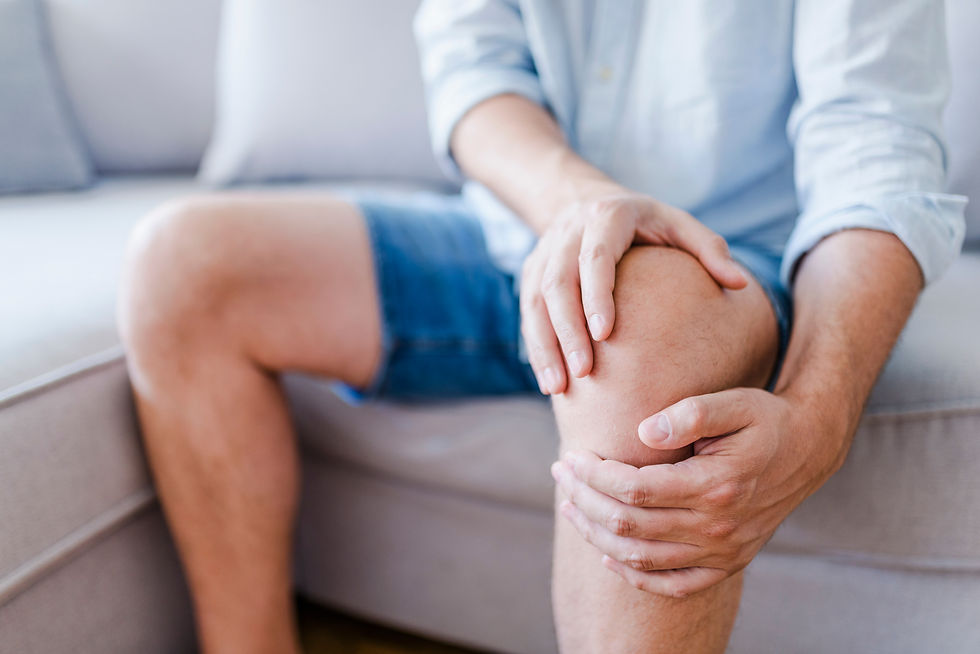The Science of Yoga Therapeutics: 7 Proven Benefits for Stress, Pain, and Mobility
- Joy Zazzera

- Feb 23
- 4 min read
Updated: Aug 6
When you’re stiff, cautious, or afraid to move, your nervous system is doing exactly what it’s designed to do—protect you. But when protection turns into avoidance, it can lead to deeper restriction, discomfort, and disconnection. That’s where yoga therapeutics comes in.
This science-informed, personalized approach to movement uses the “a little and often” method to help reintroduce safe, accessible movement—especially for joint-sensitive adults or those recovering from injury or surgery.
More than just gentle yoga, yoga therapeutics addresses the whole system—physically, neurologically, and emotionally. Backed by tradition and current research, its benefits go far beyond flexibility or fitness.
In this post, you’ll learn about seven proven ways yoga therapeutics can support your:
Nervous system regulation
Circulation and lymphatic flow
Fascial health and myofascial mobility
Joint support and biomechanical function
Respiratory efficiency
Immune and hormonal balance
Muscular coordination and motor control
Whether you’re returning to movement after a long break, recovering from joint replacement, or just navigating the physical effects of stress, these benefits can help you feel more at ease—in your body, and in your life.
Let’s explore how.

Yoga therapeutics provides safe, science-supported ways to reintroduce gentle movement and establish trust in your body. Yoga Medicine® describes the physiological benefits of yoga therapeutics as broad, impactful, and rooted in both tradition and science. These benefits go far beyond flexibility or strength. Here are key physiological outcomes, based on Yoga Medicine's teachings and the current research they draw from:
1. Nervous System Regulation
Yoga therapeutics helps down regulate an overactive sympathetic nervous system (the “fight or flight” mode) and supports parasympathetic activation (the “rest and digest” mode). This balance promotes:
Improved sleep
Reduced anxiety and depression
Lowered heart rate and blood pressure
Enhanced emotional resilience
2. Improved Circulation and Lymphatic Flow
Through intentional movement and breathwork, yoga therapeutics supports:
Increased blood flow to tissues and joints (aiding healing and nourishment)
Enhanced lymphatic drainage (reducing swelling, improving immunity)
Improved oxygen delivery and waste removal in muscles and fascia
3. Fascia and Myofascial Health
Gentle, mindful movement improves the hydration, mobility, and elasticity of fascia—a connective tissue that wraps muscles and organs. This leads to:
Decreased stiffness
Greater joint range of motion
Pain reduction (especially in areas of compensatory tension)
4. Joint Support and Biomechanical Integrity
Yoga therapeutics works to stabilize and mobilize joints appropriately, enhancing alignment and neuromuscular control. Benefits include:
Improved balance and proprioception (your body’s awareness in space)
More efficient movement patterns
Reduced risk of re-injury or wear on prosthetic joints
5. Respiratory Efficiency
Targeted breath practices (pranayama) in yoga therapeutics can:
Increase lung capacity and diaphragmatic movement
Support heart-lung function
Reduce respiratory fatigue, particularly useful in recovery or aging populations
6. Endocrine and Immune System Support
Yoga therapeutics may positively influence hormone regulation and immune response through nervous system balance and reduced systemic inflammation. Research suggests benefits like:
Lower cortisol (stress hormone) levels
Enhanced vagal tone (linked to calmness and social engagement)
Improved immune markers over time
7. Muscular Re-education and Motor Control
By pairing movement with attention, yoga therapeutics retrains motor patterns. This helps:
Restore muscular coordination after surgery or injury
Re-establish strength without strain
Promote symmetry and sustainable movement habits

Rather than focusing on advanced shapes or “perfect” form, yoga therapeutics offers you foundational patterns you can rely on. Whether you’re standing, sitting, transitioning from a chair, or walking your dog—your body uses these core movement patterns every day. Yoga with Joy builds these into every sequence to help you function with more stability, ease, and confidence.

Learning and refining these patterns can help:
Retrain balance and gait after injury or surgery
Improve how your hips, knees, and shoulders move together
Support you through aging and movement limitation due to joint replacements, surgeries reduced flexibility
Build trust in your body through repetition and intelligent challenge
This is not a prescriptive approach. Rather, it helps you map your movement choices in real time. You’ll become more aware of how you stand, how you sit, how you shift—and that awareness helps you make supportive changes not only during class, but in daily life.
Even if you’ve been told you have poor posture or tight hamstrings or scoliosis or a “bad” back—your body still has intelligent patterns it can learn to access. You’ll explore these through a variety of beginner-accessible postures, slow transitions, and muscle activations that help you experience movement as meaningful, not mechanical.
We must remember that we have an incredible capacity to self-regulate—not only how we feel, but how we move, breathe and think. In times of stress or uncertainty, we can return to healthy routines that support stamina, calm, and resilience. How we feel emotionally matters just as much as how we move physically. Movement and emotion are connected. When the body feels safe, the mind often follows. This is the essence of yoga therapeutics. And this doesn’t require advanced practice. What matters is the regular inclusion of just enough yoga therapeutics to make your quality of life better right now.







Comments